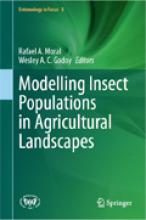The term agricultural landscape has become increasingly present in scientific texts. Its use makes possible a more comprehensive view of the aspects involved in crops and refuge areas, facilitating a deeper understanding of the biological processes inherent to the system. The concept of an agricultural landscape involves interactions between their primary elements: agriculture, environment, and natural resources. A brief reflection on this topic indicates that agricultural landscapes are highly complex systems, demanding specific tools to retain their main aspects, thus facilitating a quick interpretation of their nature and respective problems. The concept of a mathematical model meets this demand since models provide a simplification of systems, and because of this, they can be seen as “caricatures” of complex systems in which themain features correspond to the essence of the system. Entomology provides systems rich in interactions between organisms and plants dis-tributed in several different agricultural mosaics, which offer intriguing interactive scenarios (especially in tropical areas), but also pose challenging demands in terms of experimental design and mathematical and computational modelling. Although the models have played a significant role in understanding population patterns and predicting relevant scenarios for pest ecology, management, and conservation of natural enemies, laboratory and field studies can provide validation or a basis for theoretical developments, and have led to numerous advances in entomology over many years. The connection between models and data experimentally obtained has contributed to the establishment of a highly relevant database for studying agricultural landscapes. This book also reflects several decades of research devel-opment and teaching to undergraduate and graduate students at South American and European universities. Each chapter brings the authors’ perspectives on what is essential when carrying out research at the interface between entomology and mathematical/statistical/computational modelling.
ISBN: 978-3-031-43097-8





